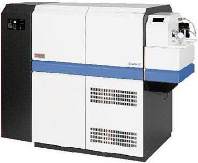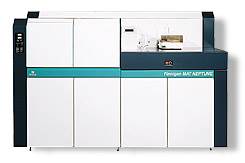For isotope analysis, ALS Scandinavia uses different forms of ICP-MS, i.e. mass spectrometry with inductively coupled plasma as the ion source. The plasma is formed by argon gas flowing through a radio- frequency field. Among the advantages of ICP is the ease of sample introduction. Especially, solutions can be introduced continuously since the plasma operates at atmospheric pressure.
In most cases, the requirements on measurement uncertainty will determine which technique is most appropriate for a specific project.
ICP–SFMS
 |
In this technique, a magnetic sector is used as the mass analyzer (SF = sector field), which distinguishes ICP-SFMS from the more common quadrupole ICP-MS (ICP-QMS). The sector technique is also called High-Resolution ICP-MS because of the higher mass resolution of the magnetic sector compared to the quadrupole. The precision in isotope ratio measurements by ICP-SFMS under optimum conditions is better than 0.05% relative standard deviation. |
MC-ICP-MS
 |
ALS Scandinavia has also access to two multi-collector ICP-MS instruments for high precision isotope ratio measurements. In this technique, mass separation is based on a magnetic sector like in ICP-SFMS. Higher precision is made possible by simultaneous measurement of the isotopes by individual detectors. Isotope ratio precision down to 0.001% (=10 ppm) relative standard deviation can be achieved. |
Quality
ALS Scandinavia has participated in international inter-laboratory comparison studies on isotope analysis. Results are available from ALS Scandinavia on request.